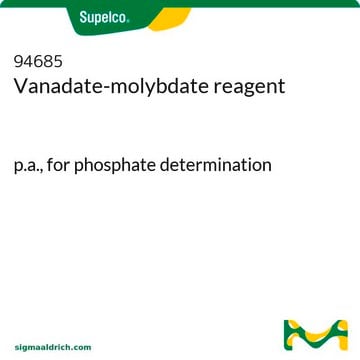A1343
Ammonium molybdate
meets USP testing specifications
Synonyme(s) :
Ammonium molybdate tetrahydrate, Ammonium heptamolybdate tetrahydrate, Molybdic acid ammonium salt tetrahydrate
About This Item
Produits recommandés
Agence
USP/NF
meets USP testing specifications
Niveau de qualité
Forme
crystals
Densité
2.498 g/mL at 25 °C (lit.)
Application(s)
pharmaceutical (small molecule)
Chaîne SMILES
N.N.N.N.N.N.O.O.O.O.O=[Mo](=O)=O.O=[Mo](=O)=O.O=[Mo](=O)=O.O=[Mo](=O)=O.O[Mo](O)(=O)=O.O[Mo](O)(=O)=O.O[Mo](O)(=O)=O
InChI
1S/7Mo.6H3N.10H2O.18O/h;;;;;;;6*1H3;10*1H2;;;;;;;;;;;;;;;;;;/q;;;;3*+2;;;;;;;;;;;;;;;;;;;;;;;;;;;;;;;;;;/p-6
Clé InChI
FIXLYHHVMHXSCP-UHFFFAOYSA-H
Vous recherchez des produits similaires ? Visite Guide de comparaison des produits
Catégories apparentées
Application
- Photochromic hydrogels for electronic applications: Ammonium molybdate was utilized in the synthesis of a polyacrylamide/sodium alginate/sodium chloride photochromic hydrogel. This hydrogel exhibits high conductivity, anti-freezing properties, and a fast response, making it suitable for information storage and electronic skin applications (Chen et al., 2024).
- Microwave absorption materials: The preparation of flower-like carbon nanosheet aggregations embedded with ultrafine Mo(2)C, where ammonium molybdate plays a critical role, offers significant advancements in microwave absorption technology (Wang et al., 2023).
Code de la classe de stockage
10-13 - German Storage Class 10 to 13
Classe de danger pour l'eau (WGK)
WGK 1
Point d'éclair (°F)
Not applicable
Point d'éclair (°C)
Not applicable
Équipement de protection individuelle
dust mask type N95 (US), Eyeshields, Gloves
Choose from one of the most recent versions:
Certificats d'analyse (COA)
Don't see the Right Version?
If you require a particular version, you can look up a specific certificate by the Lot or Batch number.
Déjà en possession de ce produit ?
Retrouvez la documentation relative aux produits que vous avez récemment achetés dans la Bibliothèque de documents.
Les clients ont également consulté
Notre équipe de scientifiques dispose d'une expérience dans tous les secteurs de la recherche, notamment en sciences de la vie, science des matériaux, synthèse chimique, chromatographie, analyse et dans de nombreux autres domaines..
Contacter notre Service technique












